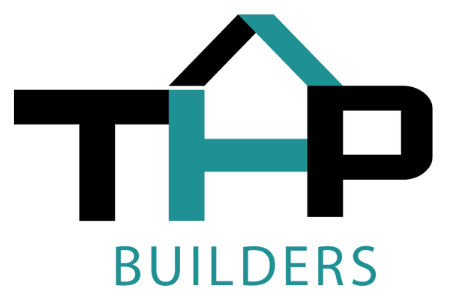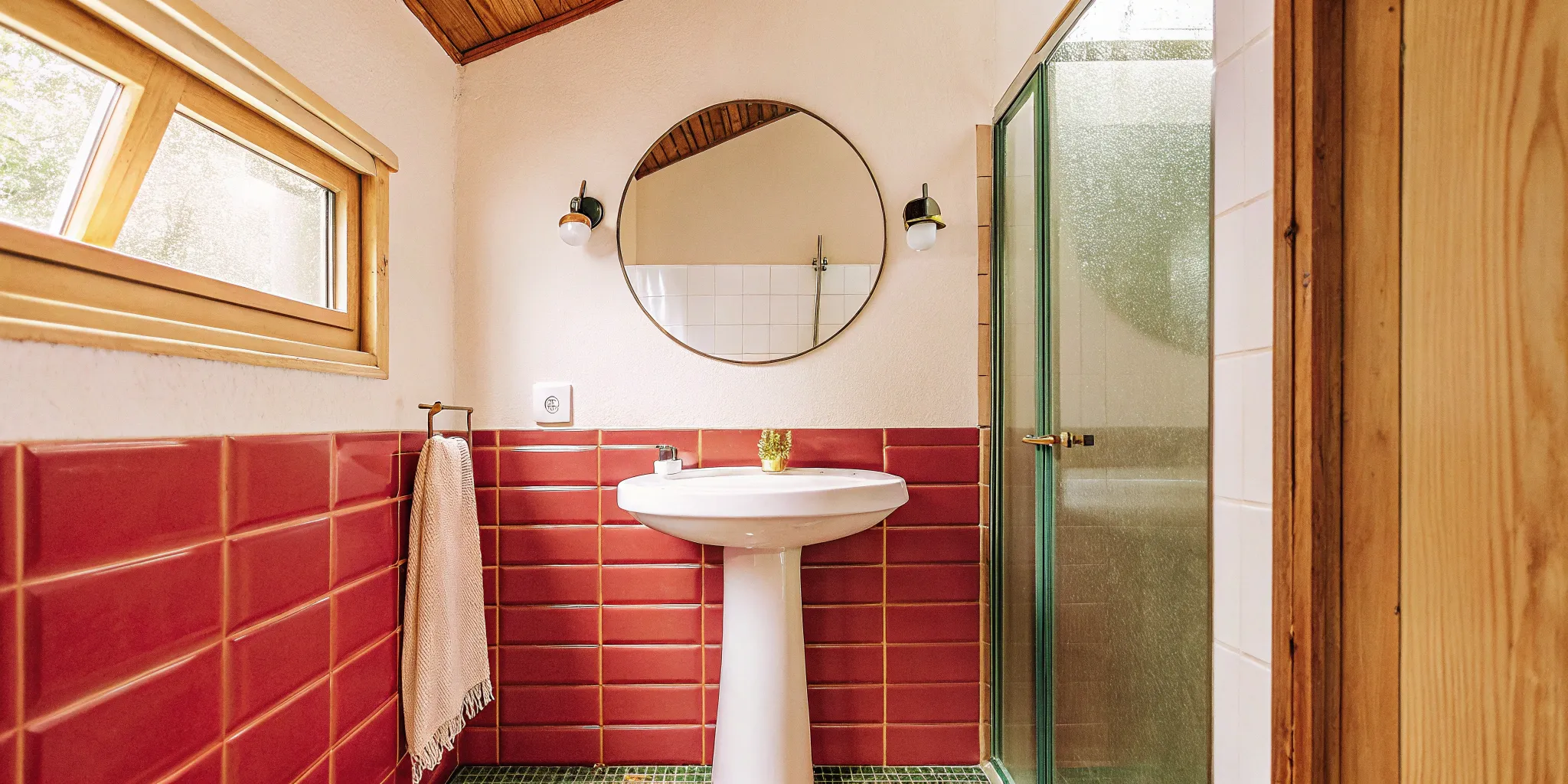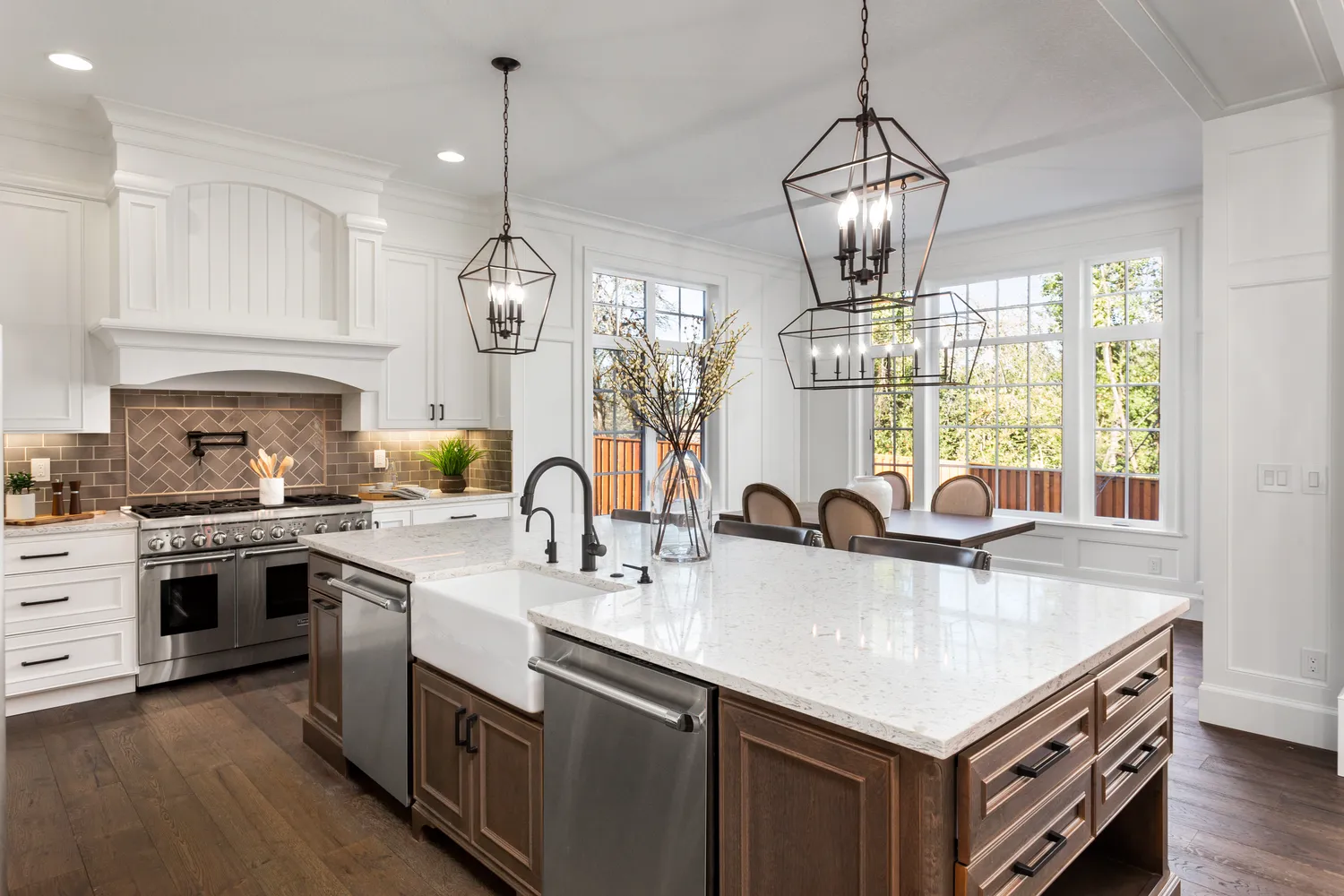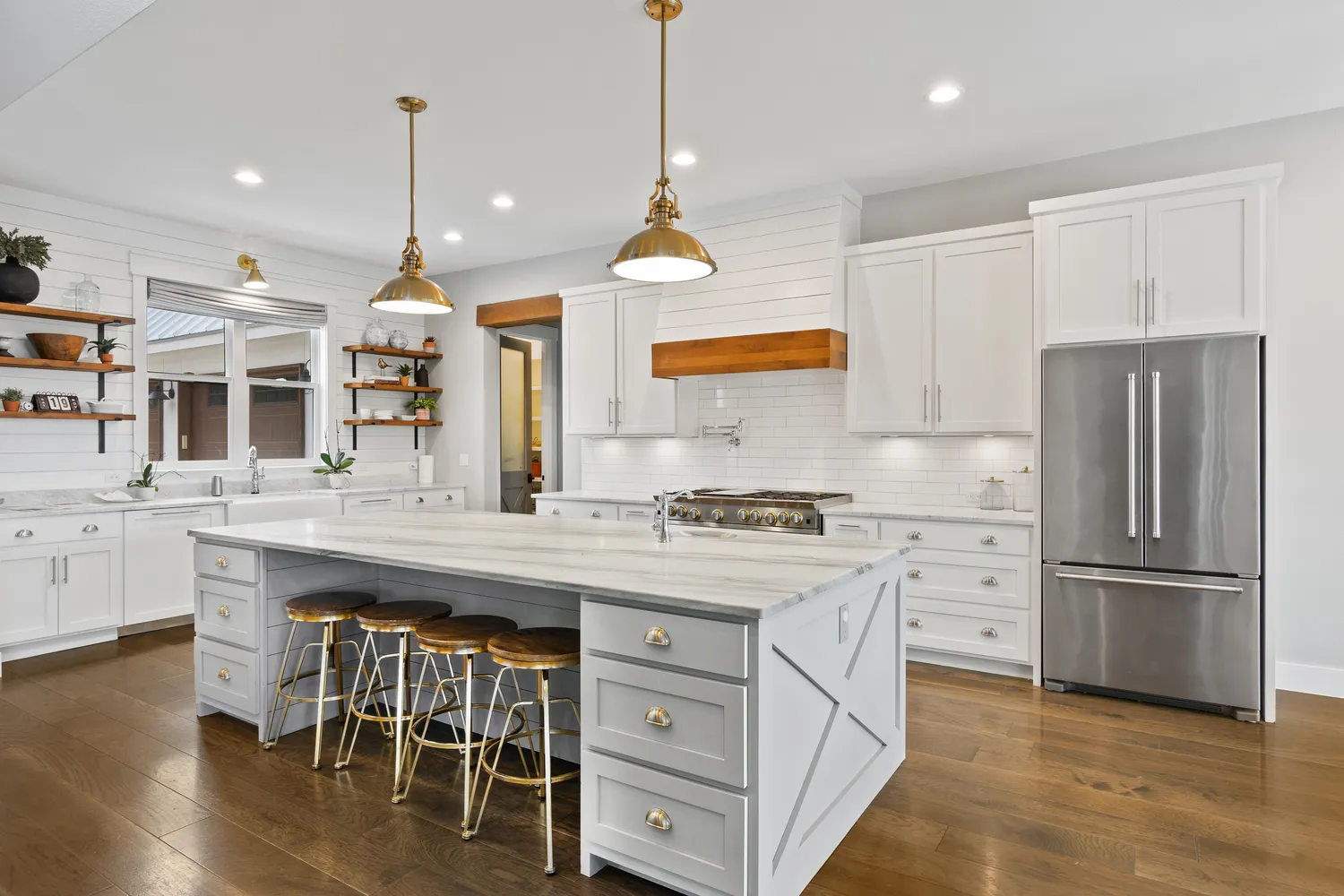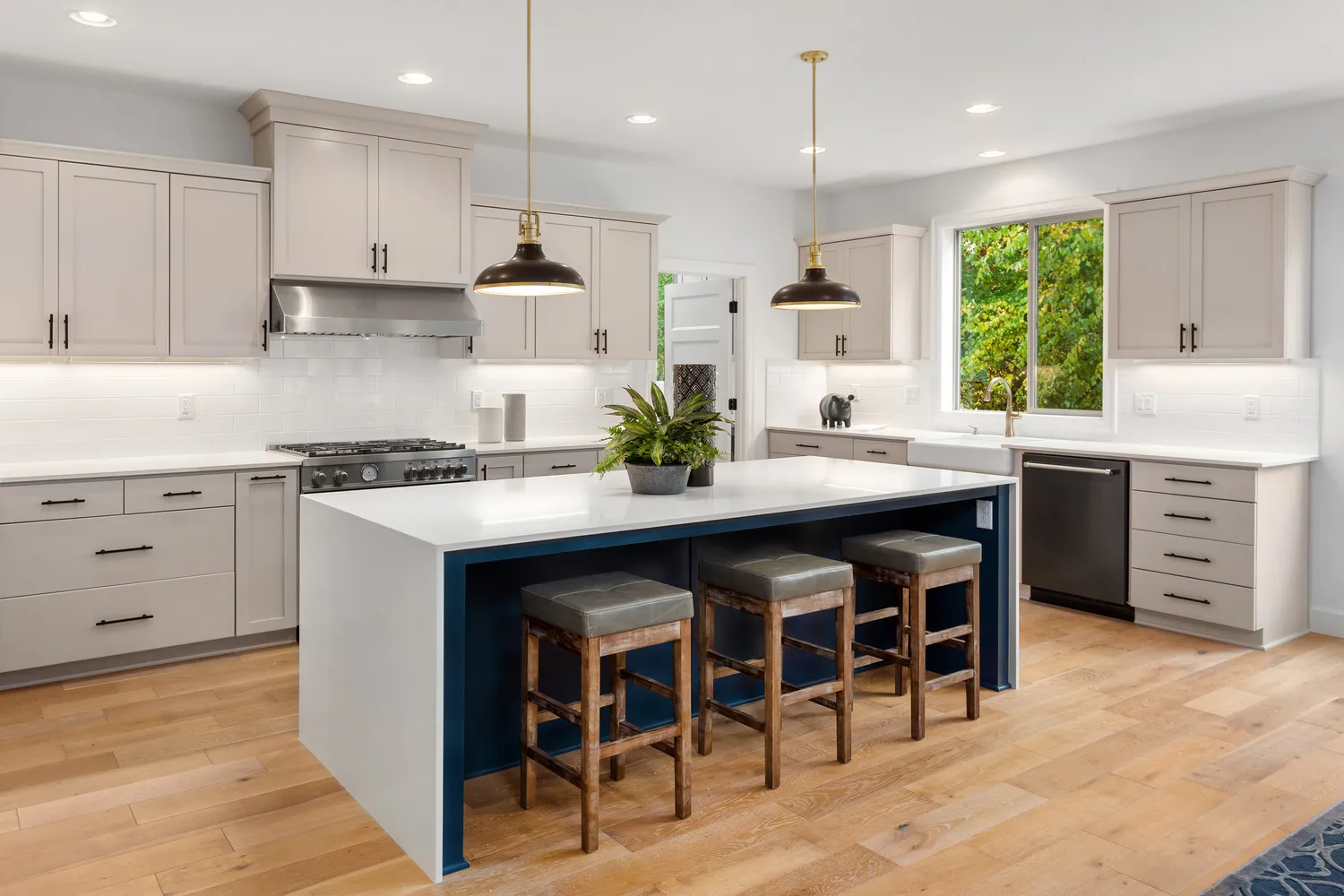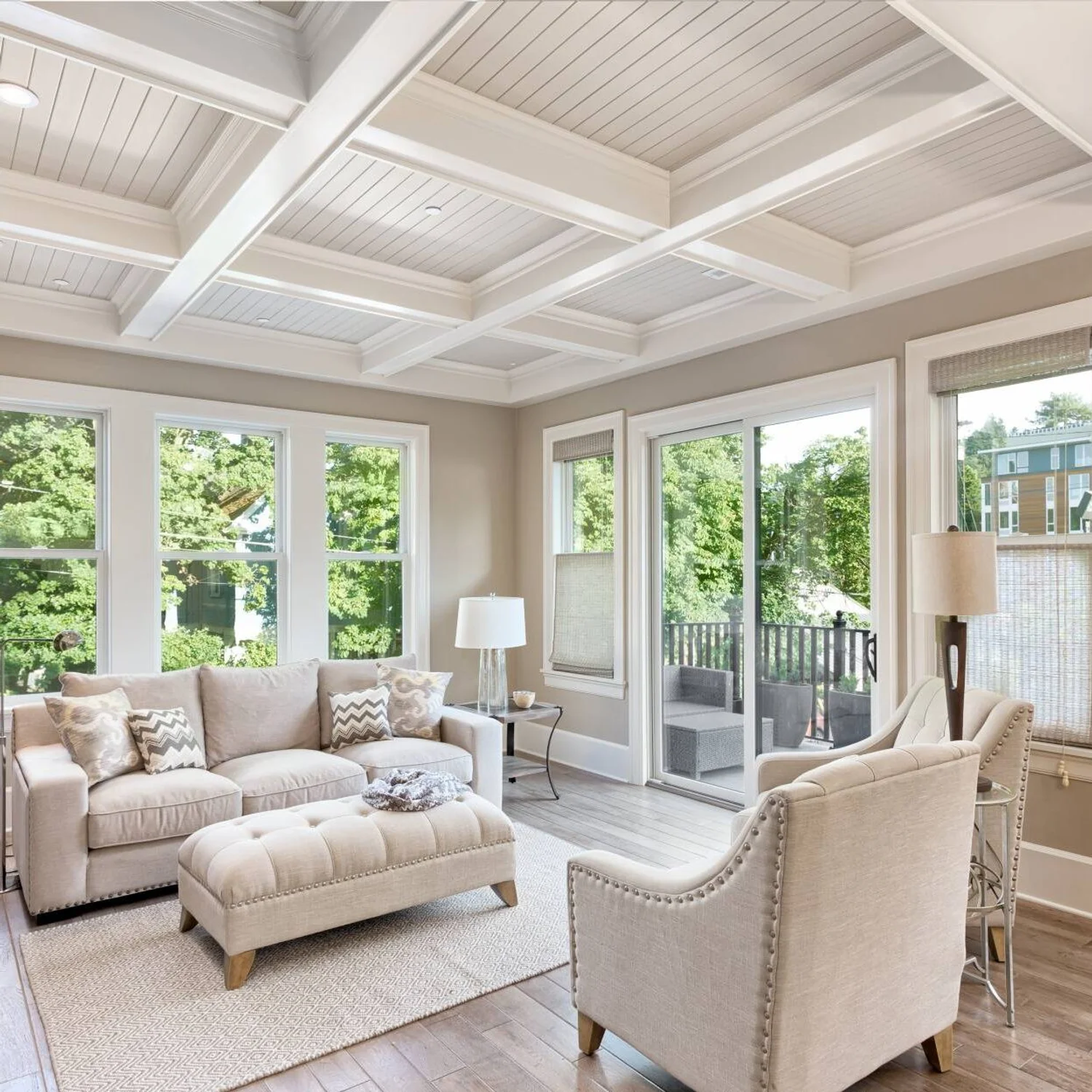That tiny bathroom in your home has so much hidden potential. While it might feel limiting now, a small footprint is actually a fantastic opportunity to get creative and make a big design impact without a massive budget. It forces you to be intentional with every choice, from the tile to the faucet, resulting in a cohesive and thoughtfully designed space. To successfully remodel very small bathroom layouts, you need to think like a designer, using visual tricks and clever solutions to create a room that feels open, airy, and luxurious. This guide is packed with actionable strategies to help you do just that, covering everything from optimizing your layout to selecting smart materials.
Key Takeaways
- Start with a plan, not just a Pinterest board: Before you pick out tile, define your budget with a 10-20% cushion for surprises, map out a realistic timeline, and take careful measurements to ensure your new fixtures will fit perfectly.
- Create the illusion of space with smart design: Make your small bathroom feel larger by using a light color scheme, layered lighting, and a large mirror. Choose space-saving options like a floating vanity or a frameless glass shower door to open up the floor plan and eliminate visual clutter.
- Know when to save and when to call a pro: Stretch your budget by saving on simple materials so you can splurge on high-impact items like a beautiful faucet. Handle cosmetic tasks like painting yourself, but leave complex jobs involving plumbing, electrical work, or layout changes to a professional to avoid costly mistakes.
How to Plan Your Small Bathroom Remodel
A successful remodel starts long before the first tile is laid. Taking the time to plan your project sets the stage for a smooth process and a result you’ll love for years to come. Think of this as creating the roadmap for your renovation. When you know where you’re going, it’s much easier to make smart decisions about your budget, timeline, and design. A well-thought-out plan is your best tool for minimizing stress and ensuring your new bathroom is both beautiful and functional.
Planning a bathroom remodel involves a few key steps. First, you need a clear understanding of what’s possible within your space and budget. From there, you can create a realistic financial plan and timeline. Finally, getting the practical details right—like precise measurements—ensures every piece of your new bathroom fits together perfectly. Let’s walk through these foundational steps together.
Set Realistic Expectations
Before you start pinning your dream bathroom on Pinterest, it’s helpful to get a handle on costs. A small bathroom remodel can range anywhere from $1,500 for a simple cosmetic update to $15,000 for a more extensive overhaul. Most homeowners find their projects land somewhere around the $6,500 mark. Knowing this range helps you understand what’s achievable. It allows you to align your vision with a realistic price point, preventing surprises down the road and helping you focus on ideas that fit your financial comfort zone.
Define Your Budget
Once you have a general cost in mind, it’s time to define your specific budget. For a quality small bathroom remodel, aiming for a budget between $6,500 and $15,000 is a practical starting point. Here’s a pro tip: always build a cushion into your budget. We recommend setting aside an extra 10% to 20% as a contingency fund. This covers any unexpected issues that might pop up, like hidden water damage or outdated plumbing that needs attention. Having this buffer gives you peace of mind and keeps the project on track without financial stress.
Create a Timeline
Understanding how long your bathroom will be out of commission is essential for managing your daily life. Most small bathroom remodels take about one to three weeks to complete from start to finish. This timeline can shift depending on the scope of your project. For example, simply replacing a vanity and toilet will be much faster than reconfiguring the plumbing and installing a new shower. A clear timeline helps you coordinate with your contractor and prepare your household for the temporary disruption.
Take Key Measurements
In a small bathroom, every inch counts. Taking accurate measurements is one of the most critical steps in the planning phase. Bathrooms are hardworking spaces, and a simple measurement error can lead to big problems, like a door that can’t open fully or a vanity that crowds the toilet. Grab a tape measure and map out your room’s dimensions, noting the locations of doors, windows, and existing plumbing. This ensures your new fixtures will fit perfectly and your final layout will be comfortable and efficient. It’s the foundation of all great design and build services.
Design a Small Bathroom That Feels Big
A small bathroom doesn’t have to feel cramped. With the right design strategies, you can create a space that feels open, airy, and functional. It’s all about making smart choices that trick the eye and maximize every square inch. From layout to lighting, these tips will help you transform your compact bathroom into a comfortable retreat.
Optimize Your Layout
The right layout is the foundation of a great small bathroom. Before you move a single pipe, think about how you use the space. If you rarely take baths, consider replacing the tub with a spacious walk-in shower. This simple change can free up significant floor space, allowing for a larger vanity or much-needed storage. A professional design and build service can help you map out a floor plan that improves traffic flow and makes the room feel more intuitive and open, ensuring every fixture is perfectly placed for both comfort and style.
Choose Colors to Maximize Space
Color has a powerful effect on how we perceive a room’s size. To make your small bathroom feel larger, stick with a light and airy color palette. Soft whites, gentle grays, and calming neutrals are excellent choices because they reflect light, creating a sense of openness. Painting the walls and ceiling the same light color can also help, as it blurs the lines between where the walls end and the ceiling begins, making the room feel taller. A monochromatic scheme with subtle variations in texture can add depth without overwhelming the space.
Use Lighting Strategically
Good lighting is one of the most effective tools for making a small bathroom feel bigger. A single, dim overhead fixture can cast shadows that make a room feel closed-in. Instead, layer your lighting. Start with a bright main light for general illumination, then add task lighting, like sconces on either side of the mirror, to eliminate shadows on your face. This combination ensures the entire room is well-lit, which helps it feel more expansive and welcoming. Proper lighting is a key part of any successful bathroom remodeling project.
Incorporate Mirrors and Glass
Mirrors and glass are your best friends in a small bathroom. A large mirror over the vanity will reflect light and the room itself, creating an illusion of depth. The bigger, the better. Another game-changing move is to replace your shower curtain with a frameless glass door. A shower curtain acts as a visual wall, cutting off a large portion of your bathroom. A clear glass enclosure, however, allows your eye to travel all the way to the back wall, making the entire room feel like one continuous space. You can see stunning examples of this in our project gallery.
Try These Visual Tricks
A few clever visual tricks can make a world of difference. Use large-format tiles on the floor or walls. With fewer grout lines, the surface appears less busy and more seamless, which helps the room feel bigger. Another great strategy is to get your vanity and storage off the floor. A wall-mounted, or “floating,” vanity exposes more floor space, creating a lighter, more open feel. You can also add simple floating shelves above the toilet for stylish storage that doesn’t add visual bulk. These small details work together to create a cohesive and spacious design.
Select Space-Saving Fixtures and Features
Once you have a layout in mind, the next step is choosing the right hardware. In a small bathroom, every single fixture matters. The toilet, sink, and shower aren’t just functional necessities; they are major players in how large and open your space feels. The good news is that you don’t have to choose between style and size. Manufacturers now offer a huge range of beautiful, compact fixtures designed specifically for tight quarters.
Choosing space-saving options can free up precious floor space, making the room easier to move around in and creating a more serene, uncluttered atmosphere. From floating vanities that create an illusion of spaciousness to sleek toilets with a smaller footprint, the right choices can transform your bathroom. It’s all about being strategic. Think about how you use the space daily and prioritize fixtures that support your routine without overwhelming the room. We can help you explore options that fit your vision and your bathroom’s dimensions perfectly during a design and build consultation.
Compact Toilets and Sinks
Let’s start with the essentials. Standard toilets and sinks can be surprisingly bulky, eating up valuable real estate. Opting for compact models is one of the easiest wins in a small bathroom remodel. Look for round-front toilets instead of elongated ones, or consider a wall-mounted toilet that hides the tank in the wall, instantly giving you several inches of extra floor space. For sinks, a pedestal sink is a classic choice for a minimalist look, while a corner sink can make use of an often-neglected area. These smaller fixtures perform just as well as their larger counterparts but are scaled to fit your space beautifully.
Small Vanity Options
A vanity is often the largest piece of furniture in a bathroom, but it doesn’t have to dominate the room. Wall-mounted or “floating” vanities are fantastic for small spaces because they expose the floor underneath, which tricks the eye into seeing a larger area. They also make cleaning a breeze. If you need the storage of a traditional vanity, look for options with a slimmer profile and clean lines. Choosing a vanity with open shelving below instead of bulky doors can also contribute to a more open, airy feel while still giving you a place to store towels and baskets.
Decide: Shower or Tub?
This is a big decision in any bathroom remodeling project, but it’s especially critical in a small one. If you rarely take baths, forgoing a tub in favor of a walk-in shower can be a game-changer. A glass-enclosed shower, rather than one with a curtain, will prevent the space from being visually cut in half. If you can’t live without the option to soak, a shower-tub combo is a practical, space-efficient solution. You can even find tubs that are slightly shorter or narrower than standard models to better fit your layout. Think about your lifestyle and what will bring you the most daily enjoyment.
Find Efficient Storage
Clutter is the enemy of a small space. That’s why smart, efficient storage is non-negotiable. Think vertically to draw the eye upward and maximize your wall space. Install floating shelves above the toilet to hold decorative items or extra toiletries. Use a ladder-style shelf for a chic way to hang towels. Inside drawers and cabinets, use dividers and organizers to keep everything tidy and accessible. The goal is to have a designated spot for everything, so your countertops can stay clear and the room feels calm and organized.
Consider Built-In Solutions
For a truly seamless and space-saving design, built-in storage is the ultimate solution. Recessed medicine cabinets or shower niches, for example, provide storage without protruding into the room. These features are built directly into the wall cavity between studs, making use of otherwise wasted space. A custom-built shelving unit designed to fit a specific nook can also provide a ton of storage with a minimal footprint. These solutions require a bit more planning and professional installation, but the payoff in a small bathroom is huge, giving you a clean, custom look you can see in our project gallery.
Choose Smart Materials on a Budget
A beautiful bathroom remodel doesn’t have to break the bank. The key is making smart, strategic choices with your materials. High-impact, low-cost updates can completely transform a small space, giving you that luxurious feel without the hefty price tag. It’s all about knowing where to invest your money for the best results and where you can find stylish, budget-friendly alternatives. From flooring to fixtures, a little creativity and planning can help you achieve the bathroom of your dreams. We can help you explore options that fit your budget and style during our design and build process. Let’s look at how you can make every dollar count.
Pick the Right Flooring
Your bathroom floor needs to be durable and water-resistant, but that doesn’t mean it has to be expensive. Luxury vinyl tile (LVT) and peel-and-stick tiles have come a long way, offering a huge variety of realistic wood and stone looks at a fraction of the cost. If you have your heart set on a pricier designer tile, consider using it as an accent. You could create a “rug” effect in the center of the room with the special tile and surround it with a more affordable, complementary option. This gives you a custom, high-end look while keeping your material costs down.
Select Your Wall Coverings
Never underestimate the power of paint. A fresh coat can instantly make a small bathroom feel brighter and cleaner. You can even find specialty paints designed to go over old wall tiles, giving them a modern update without the cost of demolition. For a textured, organic feel, consider using limewash instead of tiling the entire space. Another great option is installing beadboard or wainscoting on the lower half of the walls. This adds architectural character and protects the walls from moisture, and you only have to paint or wallpaper the top portion, saving you time and money.
Find Cost-Effective Alternatives
Think outside the big-box store for your vanity. You can often find affordable vanities at places like IKEA, or you can get creative by repurposing a piece of furniture. An old dresser, a small console table, or even a nightstand can be transformed into a unique and charming vanity. Just be sure to properly treat any wood with a water-resistant finish to protect it from splashes and humidity. For countertops, ask local stone yards if they have any remnant pieces of granite or quartz. These smaller leftover slabs are perfect for bathroom vanities and are sold at a deep discount.
Know Where to Save and Splurge
Creating a budget-friendly bathroom is about balance. You want to save where you can so you can splurge on the elements that really matter. Save on things that are simple and classic, like standard subway tile for the shower walls. Then, you can splurge on a high-impact item you’ll interact with daily, like a beautiful faucet, a statement light fixture, or custom hardware for your vanity. These are the “jewelry” of the bathroom and can make the whole space feel more luxurious. A professional can help you identify the best places to invest for a bathroom remodel that looks and feels premium.
Account for Hidden Costs
When you’re planning your budget, it’s crucial to set aside a contingency fund—typically 10% to 20% of your total project cost. Remodeling, especially in older homes, can uncover surprises. You might find hidden water damage, mold, or outdated electrical wiring once you open up the walls. Other costs to plan for include demolition and debris removal fees, building permits, and inspections. Working with an experienced contractor is the best way to anticipate these potential issues. We can provide a detailed estimate that accounts for these variables, so you can move forward with confidence.
Avoid These Common Remodeling Mistakes
A small bathroom remodel is an exciting project, but it comes with its own set of challenges. With limited space, every decision counts. Even small missteps can lead to a room that feels cramped, cluttered, or just doesn’t function well. Planning ahead and being aware of common pitfalls is the best way to ensure your new bathroom is a space you’ll love for years to come. Let’s walk through some of the most frequent mistakes homeowners make so you can steer clear of them.
Common Design Pitfalls
It’s easy to get swept up in beautiful inspiration photos, but one of the biggest mistakes is sacrificing function for style. A pedestal sink might look chic, but it offers zero counter space or storage. Similarly, a bold, busy tile pattern can overwhelm a tiny room, making it feel smaller and more chaotic. When designing your space, think about how you use it every day. Prioritize a layout and fixtures that make your routine easier. Our bathroom remodeling projects always start with a deep understanding of your needs to create a space that is both beautiful and practical.
Forgetting Ventilation
Never underestimate the importance of good ventilation. Bathrooms are high-moisture environments, and without a way for that steamy air to escape, you’re creating a perfect breeding ground for mold and mildew. A major renovating mistake is not planning for adequate ventilation from the start. Over time, this can lead to peeling paint, warped cabinetry, and even structural damage. A high-quality, properly sized exhaust fan isn’t a luxury; it’s a necessity. Make sure it’s included in your plan and vented correctly to the outside, not just into an attic space.
Poor Storage Planning
In a small bathroom, clutter is the enemy. That’s why poor storage planning is a critical error. Countertops piled high with toiletries and towels stacked on the toilet tank can make even the most beautifully designed bathroom feel messy and stressful. Adding some type of storage space is a must, so prioritize this during your renovation. Think vertically with tall, narrow cabinets, or consider built-in solutions like a recessed medicine cabinet or shower niches. A vanity with deep drawers is often more efficient than one with a large, open cabinet. Smart design and build services integrate storage seamlessly into the overall plan.
Underestimating the Budget
One of the biggest errors homeowners make is rushing into a remodel without a well-thought-out budget. It’s crucial to account for every detail, from the major fixtures down to the drawer pulls and light switches. More importantly, always include a contingency fund of at least 15-20% of your total budget. Remodeling older homes often uncovers surprises behind the walls, like outdated plumbing or hidden water damage. Having that cushion prevents unexpected costs from derailing your project. A detailed plan helps you avoid frustration and ensures you can complete the bathroom of your dreams.
Inefficient Layouts
The layout is the foundation of your bathroom’s functionality. A common mistake is trying to cram too much into a tight space or ignoring the flow of the room. Can the door open all the way without hitting the toilet? Is there enough elbow room at the sink? Can you comfortably step in and out of the shower? These are critical questions to answer. An inefficient layout can make a bathroom feel awkward and frustrating to use every single day. Carefully measuring your space and creating a to-scale floor plan will help you visualize the final result and catch potential issues before construction begins.
Should You DIY or Hire a Pro?
Deciding how much of your small bathroom remodel to tackle yourself is a big question. While rolling up your sleeves can be rewarding, it’s important to be realistic about your skills, time, and the complexity of the job. A successful project is all about knowing when to grab your toolbox and when to call in an expert. Let’s break down what makes sense for a DIY project versus what’s best left to a professional.
What You Can DIY
If you’re looking to save some money, taking on a few cosmetic tasks is a great way to contribute to your remodel without getting in over your head. Doing some of the work yourself, like hanging wallpaper or painting, can significantly cut down on labor costs. These surface-level updates can make a huge impact on the look and feel of your small bathroom. Other manageable DIY projects often include swapping out cabinet hardware, replacing a faucet, installing a new vanity light fixture (if the wiring is already in place), or putting up new shelves. These tasks let you put your personal stamp on the space while leaving the more technical aspects to someone with experience.
When to Call a Professional
Some parts of a bathroom remodel are simply not DIY-friendly unless you have specialized training. It’s time to call a professional for any project that involves changing the room’s layout, moving plumbing, or altering electrical wiring. Tasks like tiling, leveling a floor, installing a new shower door, or redirecting pipes are challenging and carry a high risk of expensive mistakes if done incorrectly. A licensed contractor ensures that all work is done safely and correctly, preventing future issues like leaks or electrical hazards. For a project as important as a bathroom remodel, hiring an expert provides peace of mind and a high-quality, lasting result.
Understand Permits and Regulations
One of the most overlooked aspects of a bathroom remodel is the need for permits. Many Chicagoland municipalities require permits for any work that involves plumbing, electrical, or structural changes. A major renovating mistake is not planning for proper ventilation, which is often mandated by local building codes to prevent mold and moisture damage. Navigating these regulations can be confusing, but it’s a critical step. A professional general contractor is well-versed in local codes and will handle the entire permitting process for you, ensuring your new bathroom is not only beautiful but also safe and compliant. This is a key part of any design and build service.
Manage Your Project Effectively
A smooth remodel hinges on a solid plan. One of the biggest errors homeowners make is rushing into a project without thinking through every detail, which often leads to unexpected costs and frustrating delays. Managing a remodel involves coordinating multiple tradespeople—from plumbers to electricians to tilers—and ensuring everyone stays on schedule and on budget. This can quickly become a stressful, full-time job. When you hire a professional team, you get a dedicated project manager who handles all the logistics. They create a realistic timeline, manage the budget, and solve problems as they arise, allowing you to enjoy the process without the headache.
Add the Finishing Touches
With the major construction complete, it’s time for the details that truly bring your new bathroom to life. This final phase is all about adding personality and ensuring the space is as functional as it is beautiful. From hardware to towels, these finishing touches are what transform a construction zone into your personal oasis. It’s where all your planning pays off and you get to see your vision become a reality.
Coordinate Your Finishes
Creating a cohesive look comes down to the finishes you choose. Think of hardware, faucets, and light fixtures as the jewelry of your bathroom. Whether you prefer matte black, brushed nickel, or warm brass, keeping these elements consistent creates a polished and intentional design. Look for mirrors and lights that complement your vanity and overall style. Even smaller accessories like your soap dispenser, toothbrush holder, and trash can contribute to the final look, so make sure they match or coordinate well with your main fixtures. You can find plenty of inspiration for beautiful, coordinated spaces in our project gallery.
How to Live Through the Remodel
Let’s be honest: living without a key bathroom can be a challenge. The best way to handle the disruption is to plan ahead. If you have another bathroom, stock it with everything your family will need. If not, talk with your contractor about the project timeline so you can make temporary arrangements. Clear communication is key to a smooth process. A professional team will keep you informed and work to minimize the impact on your daily life. Remember that a bathroom is a high-moisture area, so proper ventilation is essential not just for comfort, but for the longevity of your new space.
Style Your New Bathroom
Now for the fun part: styling! This is where you can inject color and personality. Choose plush towels, a stylish shower curtain, and a soft bath mat that tie your color scheme together. Don’t be afraid to hang some waterproof art or add a small plant that thrives in humidity, like a snake plant or an orchid. Even functional items like a toilet paper holder can add a touch of style. The best part about these decorative elements is that they aren’t permanent. If you want a fresh look in a few years, you can easily swap them out without needing a full bathroom remodel.
Plan for Long-Term Maintenance
To keep your new bathroom looking great for years, think about maintenance from the start. When selecting materials, ask about their durability and cleaning requirements. For example, non-porous countertops and large-format tiles with minimal grout lines can make cleaning much easier. While some tasks are simple, complex jobs involving plumbing, electrical work, or tiling are best left to a professional to prevent future issues. A quality contractor will not only build a beautiful space but will also provide guidance on how to care for it properly, ensuring your investment lasts. If you have questions about your project, feel free to contact our team.
Related Articles
- Designing Your Personal Spa: Bathroom Renovations – THP Builders & Remodeling
- Bathroom Remodeling Near Me Arlington Heights | THP Builders LLC
- Bathroom Remodeling – THP Builders LLC
- Bathroom Remodeling Near Me Deerfield | THP Builders LLC
- Kitchen Remodeling Ideas for Small Kitchens
Frequently Asked Questions
How much should I realistically budget for a small bathroom remodel in Chicagoland? While the post gives a range of $6,500 to $15,000, where you land depends on your choices. A simple cosmetic refresh with new paint, a vanity, and a toilet will be on the lower end. If you plan to move plumbing, install custom tile, or add a glass shower enclosure, you’ll be closer to the higher end. The most important thing is to set aside an extra 15-20% as a contingency fund. In older Chicago homes, it’s common to find surprises like old plumbing or hidden water damage once the walls are opened up.
What’s the one change that makes the biggest impact in a small bathroom? If you want the most significant change, focus on the shower area. Replacing a traditional shower curtain with a frameless glass door instantly makes the entire room feel larger because your eye can see all the way to the back wall. If you don’t use your bathtub often, swapping it for a spacious walk-in shower with a glass enclosure is an even bigger game-changer. It removes a large visual barrier and completely transforms the sense of space.
How long will my bathroom actually be unusable during the remodel? The timeline really depends on the scope of the work. A straightforward cosmetic update might only take a week. However, a full renovation that involves moving plumbing, extensive tile work, and custom installations will likely take closer to three weeks. A professional contractor will give you a detailed schedule before work begins, so you know exactly what to expect and can plan for the disruption to your daily routine.
Do I really need to hire a professional for a small project? If you’re just painting or swapping out a light fixture, you can probably handle it yourself. But for anything involving plumbing, electrical work, or tiling, hiring a professional is the smartest move. A small mistake, like an improperly sealed shower, can lead to thousands of dollars in water damage down the road. A licensed contractor also handles all the necessary permits and ensures your remodel is up to code, protecting your home’s value and your peace of mind.
What’s the most common mistake you see people make with small bathrooms? The biggest mistake is not planning for enough storage. It’s easy to fall in love with a sleek pedestal sink or a minimalist design, but if you don’t have a practical place to put your daily essentials, your beautiful new bathroom will quickly become cluttered and frustrating. Always prioritize function alongside style by incorporating smart storage solutions like a vanity with deep drawers, a recessed medicine cabinet, or vertical shelving.
